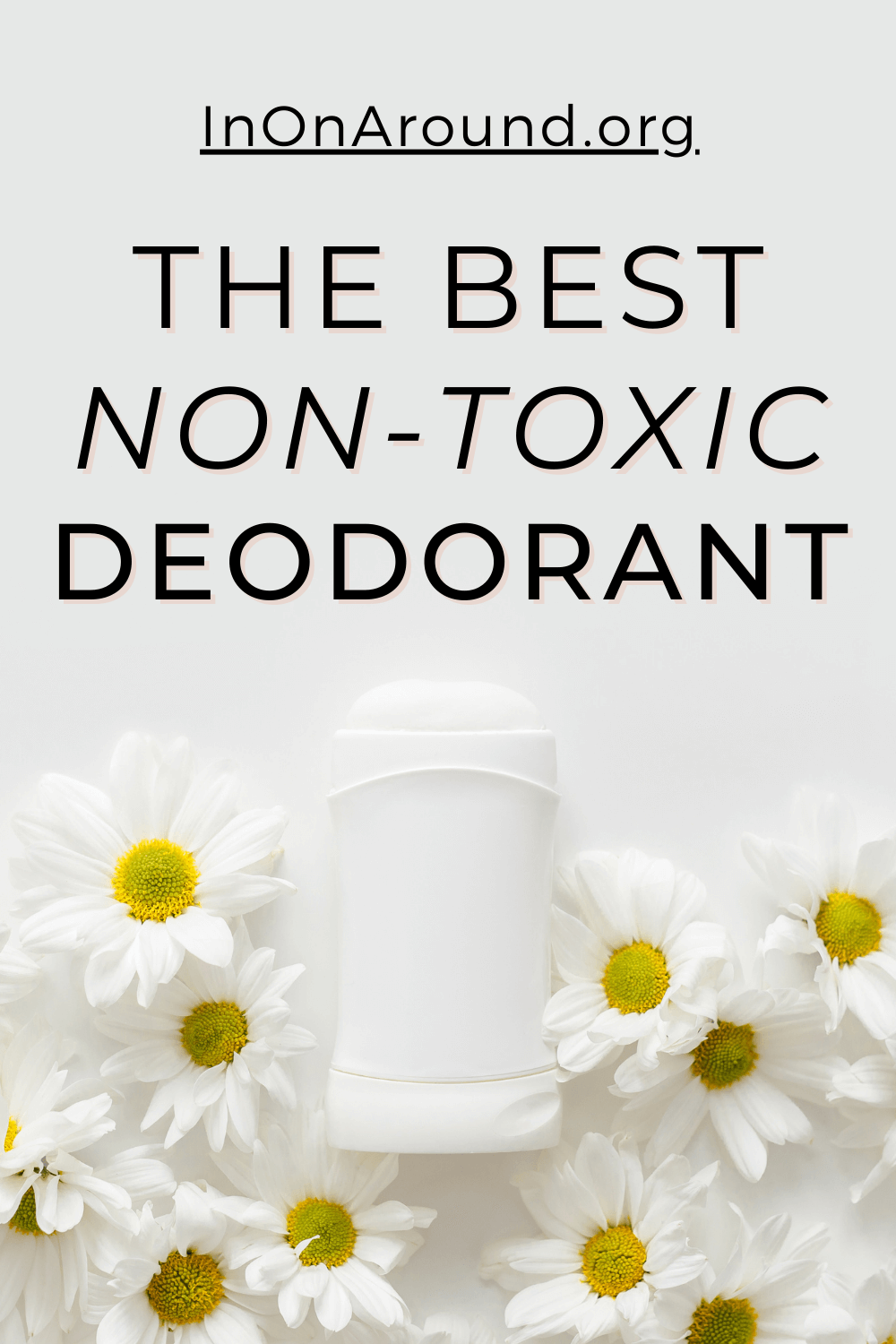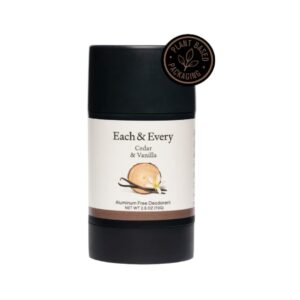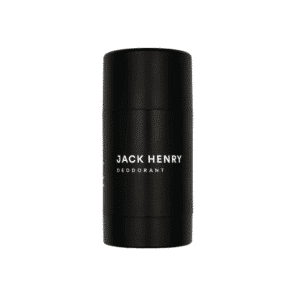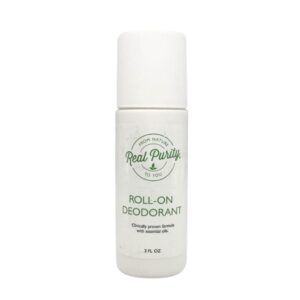Switching from antiperspirant to non-toxic deodorant is no easy feat. Natural deodorant can be tricky to master, especially if you sweat a lot or suffer from hyperhidrosis (excessive sweating). It certainly requires persistence and experimentation, but there are plenty of safer aluminum-free deodorant options that can keep you odor-free. What are the best natural deodorant brands? Why should you use healthier deodorants? How can you make the switch?
Don’t sweat it! I’ve got you covered with 58+ great options for both men and women. Keep reading to learn more about the healthiest non-toxic deodorants.

Note: This article contains affiliate links, meaning In On Around will make a small commission at no additional cost to you. This helps me maintain the site. As always, I value full transparency & only work with brands I love and trust.
What Is Natural Deodorant?
As the name states, natural deodorant is a type of deodorant that’s formulated with more natural ingredients instead of synthetic ingredients. Many use essential oils, clay powders, botanicals, and other plant extracts to tackle odor and try to absorb wetness.
Unlike antiperspirants, which block sweat glands to prevent perspiration, natural deodorants work to neutralize odor-causing bacteria and keep you smelling fresh without interfering with the body’s natural sweating process. Natural deodorants are becoming increasingly popular as people seek safer and more sustainable alternatives to traditional antiperspirants (… for good reason)!
Antiperspirants are classified as drugs. Deodorants are classified as cosmetics.
Important distinction: natural deodorant is NOT the same as an antiperspirant. The focus is to help prevent body odor, not stop you from sweating. Antiperspirants are actually classified by the United States Food & Drug Administration as drugs since they inhibit a natural bodily function. Our bodies need to sweat! We have between 2 to 4 MILLION sweat glands – yes, quite a lot! [2]
Of course, there’s a lot to consider when shopping for deodorants, such as ingredient safety, scent, longevity, application type, and consistency. Finding one that works for you is NOT one-size-fits-all. It will take trial-and-error. Let’s dive into why this matters.
The Importance of Using Non-Toxic Deodorant
Many people are swaying away from antiperspirants because of their use of aluminum. While the science is still growing, aluminum is potentially linked to breast cancer and Alzheimer’s. While the Food & Drug Administration (FDA) and American Cancer Society consider aluminum “safe to use,” many people who are diagnosed with breast cancer or Alzheimer’s are told to stop using antiperspirants altogether.
With 1 in 3 women getting cancer within their lifetimes, breast cancer being the most prevalent, this is very relevant. [1] The National Cancer Institute reviewed existing research and decided that more research is needed. Some other countries, like Switzerland, have considered banning products with aluminum salts altogether. [3]
Clearly, we don’t fully know all of the potential health impacts that antiperspirants can have on our long-term wellbeing.
In recent years, there have been several antiperspirants recalled due to the presence of benzene, a chemical known to cause cancer and other health problems. Benzene is a known carcinogen that has been linked to various types of cancer, and exposure to even small amounts of the chemical over long periods of time can increase the risk of developing these diseases.
Luckily, there are powerful odor-fighting deodorants free of potentially harmful chemicals, which we’ll dive into in this article.

11 Chemicals In Antiperspirants (Side Effects Explained)
It’s best to limit the use of products that contain these ingredients. Let’s dive into some of the potentially toxic ingredients found in many antiperspirants and deodorants…
1 – Aluminum Salts
Aluminum’s function is to stop sweat from leaving the skin’s surface. While the science is split on aluminum, there are concerns that it’s potentially linked to Alzheimer’s, breast cancer, kidney disease, and endocrine (hormone) disruption. [4, 5, 6, 7, 8]
Most of the time, antiperspirants use 10-30% aluminum chlorohydrate (especially in roll-ons and aerosols). Some crystal deodorants (which are marketed to be “natural”) use potassium aluminum sulfate, which has anti-microbial properties – this still breaks down into aluminum that can be absorbed into the skin. Aluminum zirconium tetrachlorohydrex GLY is popular amongst solid antiperspirant brands.
2 – Undisclosed Fragrance
On an ingredient label, fragrance can also be known as parfum, aroma, odor, musk, perfume, & more. This is an umbrella term that can mask thousands of chemicals. Fragrance chemicals can potentially disrupt hormones and contribute to asthma, allergies, migraines, reproductive issues, and more. [9, 10, 11, 12, 13, 14] If a brand doesn’t disclose what chemicals are used in its fragrance, you don’t know what you’re buying.
To learn more about fragrance, check out: Safe Fragrance 101
3 – Phthalates
Phthalates are chemicals that can help scents last longer. These same chemicals have been linked to hormone disruption, cancer (including breast cancer), birth defects, respiratory problems, reproductive issues, and more. [19, 20]
4 – Propylene Glycol
This is a liquid that absorbs water (or your sweat). It’s also a penetration enhancer (helping ingredients more deeply penetrate into your skin) and can lead to skin irritation. [21] This is a petroleum by-product that may also be linked to central nervous system disruption. [22]
5 – Parabens
Parabens are potentially linked to endocrine disruption, early puberty in girls, acne, male breast growth, cancer, reproductive issues, and more. They’re quickly absorbed by the skin and are widely used as preservatives. [15, 16, 17, 18]
You can learn more about parabens here: Paraben Safety – Are Parabens In Makeup Harmful?
6 – Triclosan
Triclosan is a cosmetic preservative that’s linked to skin irritation and bacterial resistance. It’s also potentially linked to thyroid and reproductive hormone disruption. [23]
7 – Alcohol
This isn’t the *worst* ingredient in skincare products, in my opinion, but it can be linked to skin irritation, redness, and ingredient penetration enhancement. It can also damage the skin’s natural barrier, making it more susceptible to environmental stressors and premature aging.

8 – Triethanolamine (TEA) and Diethanolamine (DEA)
TEA and DEA may be contaminated with nitrosamines, which are hazardous carcinogens. They’re also potentially linked to cancer, reproductive harm, and skin irritation. [24]
9 – Talc
This can be contaminated with asbestos, which is a known human carcinogen, especially linked to mesothelioma. It’s also potentially linked to inflammation and ovarian cancer.
10 – Isobutane
Isobutane is a chemical commonly found in aerosol deodorants, but it is a volatile organic compound (VOC) and its use has been associated with potential health risks such as skin irritation, respiratory issues, and even cancer.
There have been cases where benzene has been detected as a contaminant in some isobutane-based products, including certain antiperspirants and aerosol sprays, due to contamination during the manufacturing process.
11 – Nano-particles
Nanoparticles are extremely small particles that may be better absorbed through the skin or through inhalation. They’re potentially linked to inflammation and can cross the blood-brain barrier. It’s best to opt for non-nano particles, especially if using sprays or powders.
Note: Some people are sensitive to natural deodorants because of baking soda. While baking soda is not harmful, it can cause skin sensitivity for some.
Do Non-Toxic Antiperspirants Exist?
Frankly, no. Non-toxic antiperspirants do not exist since antiperspirants use aluminum. “Non-toxic” and “aluminum” are oxymorons. It’s typically impossible to find non-toxic deodorants that contain aluminum.
There is no such thing as a completely non-toxic antiperspirant, as all antiperspirants rely on some form of active ingredient to reduce sweating, which may have some potential health risks.
How To Make The Switch To Non-Toxic Deodorant
Let’s dive into some simple tips for transitioning to a natural deodorant! It’s essential to find the right natural deodorant for you! Avoid these common pitfalls when making the switch.
1 – Expect An Adjustment Period
When switching to natural deodorants, it’s common to experience an adjustment or experimentation period of up to a few weeks as your body adjusts to the absence of antiperspirant ingredients. During this time, you may notice increased sweat and odor as your body detoxifies and regulates its natural perspiration.
2 – Always Read The Label
If a brand doesn’t clearly show its full ingredient list on its website, ditch it. Don’t fall victim to “all-natural” or “non-toxic” marketing – these terms are not federally regulated. Always, always, always read the full ingredient label (not just the “main ingredients” list), even if it’s a brand you’ve used before.
3 – Avoid Aerosol Sprays
Opt for solid deodorant sticks over aerosol or sprays, to avoid the potential risk of inhalation. Exposure to aerosol sprays can increase the risk of respiratory issues and inhalation of the spray particles.
4 – Try an Underarm Detox
If a natural deodorant doesn’t initially work, sometimes you need to “detox” your underarms from years & years of chemical exposure and buildup. Trying an underarm detox recipe can help to remove buildup from conventional deodorants, reduce odor, and promote healthier underarm skin.
Underarm Detox Mask Recipe
If you’re looking to make an armpit cleanse, try these steps:
- Exfoliate your underarms, like using hemp exfoliating mittens or sisal exfoliating pouches
- Mix bentonite clay with apple cider vinegar to create a pudding-like consistency, which will be used as an underarm detox mask
- If you’re not sensitive to baking soda (which has antibacterial properties), you can also put a mixture of water & aluminum-free baking soda on your underarms [25]
If you have sensitive skin, avoid using deodorant or underarm masks right after shaving.

5 – Switch It Up
Sometimes, a natural deodorant that used to work for you, may not anymore. Our bodies and skin microbiome can adapt to products over time. Natural deodorants can stop working over time due to a few reasons, including the build-up of sweat and bacteria on the skin, changes in diet or medication, and changes in hormonal levels. If that’s the case, keep switching it up.
6 – Reapply Often
It’s important to note that natural deodorants may not provide the same level of protection as traditional antiperspirants, so it may be necessary to reapply throughout the day, especially during periods of increased physical activity or high stress.
7 – Alternate Deodorant Options
If you have a really important day where you can’t sweat through your clothing, there’s no shame in alternating between your conventional deodorant/antiperspirant and a more natural option.
Yes, antiperspirants are far from “low-tox,” but using them 3 times a week instead of 7 times a week is a win in my book. Reducing exposures with baby steps can still make a difference. Don’t give up – it will take time.
Focus on baby steps. Reducing your use of antiperspirants can be a better option for some people.
Best Non-Toxic Deodorant Brands
Whether you have sensitive skin or you’re a heavier sweater, there are non-toxic deodorant options for you! Let’s dive into the best brands.
| Keep in mind: this review is based on INGREDIENT safety and transparency. This doesn’t mean they will 100% work for you regarding efficacy. When transitioning to natural deodorants, some trial and error testing is usually needed. What works for one person, may not work for another. I’ve personally tried some of the brands below (Agent Nateur, Truvani, etc… – both of which are great options), but not all. These are ordered alphabetically. |
-
Acure Cedarwood & Mint Deodorant
-
Acure Magnesium & Charcoal Deodorant
-
Agent Nateur Holi(stick) Deodorant
-
Agent Nateur Men Deodorant
-
Agent Nateur Rose Deodorant
-
Agent Nateur Sensitive Deodorant
-
All Good Cedarwood Deodorant
-
All Good Rose Deodorant
-
All Good Tea Tree Deodorant
-
Attitude Lemon Deodorant
-
Attitude Olive Deodorant
-
Attitude Orange Deodorant
-
Attitude White Tea Deodorant
-
Cleo & Coco Deodorant
-
Cleo & Coco Deodorant Bar
-
Each & Every Cedar Vanilla Deodorant
-
Each & Every Citrus Deodorant
-
Each & Every Coconut Lime Deodorant
-
Each & Every Lavender Lemon Deodorant
-
Each & Every Rose Vanilla Deodorant
-
Each & Every Sandalwood Deodorant
-
Discount
Earth Mama Citrus Deodorant (10% Off: inonaround)
-
Discount
Earth Mama Ginger Deodorant (10% Off: inonaround)
-
Discount
Earth Mama Lavender Deodorant (10% Off: inonaround)
-
Humble Lavender Deodorant
-
Humble Palo Santo Deodorant
-
Humble Rose Deodorant
-
Jack Henry Deodorant
-
Lovefresh Eucalyptus Deodorant
-
Lovefresh Rosewood Deodorant
-
Lulu Organics Lavender Cream Deodorant
-
Lulu Organics Vetiver Cream Deodorant
-
Madame Lemy Powder Deodorant
-
Necessaire Eucalyptus Deodorant
-
Piperwai Deodorant
-
Pretty Frank Charcoal Deodorant
-
Pretty Frank Jasmine Deodorant
-
Pretty Frank Lavender Deodorant
-
Pretty Frank Woodlands Deodorant
-
Discount
Primally Pure Blue Tansy Deodorant (10% Off: inonaround10)
-
Discount
Primally Pure Charcoal Deodorant (10% Off: inonaround10)
-
Discount
Primally Pure Geranium Deodorant (10% Off: inonaround)
-
Discount
Primally Pure Lavender Deodorant (10% Off: inonaround10)
-
Discount
Primally Pure Lemongrass Deodorant (10% Off: inonaround10)
-
Discount
Primally Pure Tea Tree Deodorant (10% Off: inonaround10)
-
Discount
Primally Pure Unscented Deodorant (10% Off: inonaround10)
-
Real Purity Roll-On Deodorant
-
Rustic Maka Lavender Mint Deodorant
-
Smartypits Lavender Rose Deodorant
-
Soapwalla Citrus Deodorant Cream
-
Soapwalla Deodorant Cream
-
Soapwalla Lavender Deodorant Cream
-
Thinksport Deodorant
-
Truvani Deodorant
-
Ursa Major Deodorant
-
Ursa Major Spray Deodorant
-
Discount
Wellnesse Deodorant (10% Off: inonaround)
Best Brands Listed:
- Agent Nateur Holi(stick)
- Primally Pure
- Truvani
- Cleo and Coco
- Thinksport
- PiperWai
- Beauty By Earth Magnesium Deodorant
- LoveFresh
- Ursa Major
- Acure
- All Good
- Each & Every Deodorant
- Soapwalla Deodorant Cream
- Lulu Organics Deodorant Cream
- Real Purity Roll-On Deodorant
- Attitude Deodorant
- Earth Mama Deodorant
- Humble
- Pretty Frank
- Necessaire Eucalyptus Deodorant
Some other products with great ingredients: Meow Meow Tweet Baking Soda Free Cream, Healthynest Deodorant, & Just Ingredients.
| This is certainly not an exhaustive list. There are many, many brands of deodorants on the market. Always read the ingredient label, even if it’s a brand you’ve used before. Ingredient labels can change over time as they’re re-formulated. |
Better Non-Toxic Deodorant Brands
These don’t fall into the “best” category either because they contain alcohol or because they’re owned by a larger conglomerate.
- Native – only their Lavender Rose, Cucumber Mint, or Unscented versions.
- Owned by Procter & Gamble
- Their other scents contain undisclosed fragrance
- Schmidt’s – only their Lavender Sage.and Bergamot Lime scents
- Owned by Unilever
- Their other scents contain undisclosed fragrance
- Pit Liquor – contains vodka as the first ingredient, which is antimicrobial, but alcohol can be a skin irritant for some people. Can be inhaled from the spray bottle.
- Not in the “worst” category because the ingredients, besides alcohol, are transparent and clean
- Erbaviva Organic Deodorant Spray – contains alcohol as the first ingredient, which can be a skin irritant for some people. Can be inhaled from the spray bottle.
- Not in the “worst” category because the ingredients, besides alcohol, are transparent, organic and clean
- Dr. Squatch – only the Alpine Sage scent
- Their other scents use undisclosed natural fragrance
- Smartypits – only the Lavender Rose scent
- Indie Lee Deodorant – contains phenethyl alcohol
Check Out The In On Around Shop
“Natural” Deodorant Brands To Skip
These brands use undisclosed fragrances or other ingredients that don’t meet my standards. Don’t fall victim to their marketing tactics!
- Lume – uses undisclosed fragrance; owned by Harry’s
- Kopari – uses undisclosed fragrance
- Weleda Spray Deodorant – uses undisclosed fragrance & can be inhaled from the spray bottle
- Pacifica – uses undisclosed fragrance, listed as “parfum” on the label
- Thai Crystal – uses potassium alum (aluminum)
- Crystal Deodorant Stick – uses potassium alum (aluminum)
- Nakd. Thai Crystal Deodorant – uses potassium alum (aluminum)
- Saje Natural Deodorant Spray – uses potassium alum (aluminum) & can be inhaled from the spray bottle
- Freedom Deodorants – uses a “proprietary blend of natural fragrance and essential oils”
- Corpus Naturals – uses undisclosed fragrance
- Alo Yoga Scented Deodorant – uses undisclosed fragrance and proctone olamine (which is an ethanolamine that can form carcinogenic nitrosamines)
- Love Beauty And Planet – owned by Unilever & uses undisclosed fragrance, grapefruit seed extract, and benzyl salicylate.
- Tom’s of Maine – uses undisclosed fragrance and talc, in some products
- Every Man Jack – uses undisclosed fragrance
- Lavanila Healthy Deodorant – uses undisclosed fragrance
- Megababe Daily Deodorant – uses undisclosed fragrance and phenoxyethanol
Dove and Secret have come out with 0% aluminum deodorant options. While they’re aluminum-free, they contain other potentially harmful ingredients, like undisclosed fragrances, propylene glycol, and more.
Final Thoughts – Healthy Deodorant
Clearly, there are several natural deodorant options available that can help you stay fresh and odor-free without the use of harsh chemicals. Trust me, no one likes being stinky. If the first one you try doesn’t work, try another one! Frankly, you will likely need to try a couple of different brands to find one that works the best for you. Switching to less toxic deodorant will reduce your daily exposure to unnecessary chemicals.
⬇ Pin this “Best Non-Toxic Deodorant?” pic on Pinterest for future reference! ⬇

Frequently Asked Questions – Non-Toxic Deodorant
Click on the below FAQs to learn more about deodorant toxicity and the least toxic deodorants that are better for your health & more environmentally friendly.
Can Natural Deodorants be Effective?
How Often Do You Need to Apply Natural Deodorants?

The frequency of applying natural deodorants depends on various factors like the individual’s body chemistry, the type of activity they engage in, and the specific deodorant formulation. In general, it’s recommended to reapply natural deodorants every 4-6 hours or as needed to maintain odor protection.
Are Natural Deodorants Safe for Children?
Are Non-toxic Deodorants Effective For Heavy Sweating?
Have you tried non-toxic deodorant?
Let me know your thoughts and key takeaways in the comments below!
You can watch our web story here.
xoxo,

Want to read more? Check out my other articles here!
Other references on Natural Non-Toxic Deodorants: Leaf Score, Because Health, Allure, Elle, Goop, Mamavation, NY Magazine, Conscious Life & Style, Coco Eco, Sustainably Kind Living, Nature’s Nurture, The Good Trade, Mindful Momma, Gimme The Good Stuff, Healthline, Hello Natural Living, The Honest Consumer, Good Face Project, Cleveland Clinic, Roam And Thrive, Mamavation, Pure And Simple Nourishment, Everyday Health, Class Action,
Copyright In On Around LLC 2023 ©. The statements made on this website have not been evaluated by the FDA (U.S. Food & Drug Administration). They are not intended to diagnose, treat, cure, or prevent any disease. The information provided by this website should not be used as individual medical advice and you should always consult your doctor for individual recommendations and treatment. The information contained in this site is provided on an “as is” basis. Related to this site, there are no guarantees of completeness, accuracy, usefulness, or timeliness. In On Around LLC assumes no responsibility or liability for any errors or omissions in the content of this site.



























































